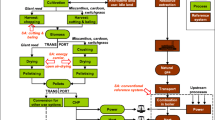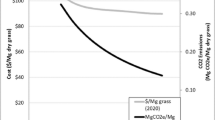Abstract
Using bio-fuels, such as bio-ethanol or bio-diesel in transportation, or biomass in power generation reduces CO2 emissions as the carbon is fixed by the plants from the atmosphere and saves the equivalent fossil fuel. The perennial rhizomatous C4 grass Miscanthus has one of the highest energy intensities per hectare of land in Europe. Here we model the future potential of Europe to produce Miscanthus with four different future land use and climate change scenarios and conclude that up to 17% of Europe’s current primary energy consumption could be provided by this bio-energy crop by the year 2080 but that inter-annual variation of crop yield can be more than 20%. We conclude that that the highest greenhouse gas mitigation from bio-energy can be achieved by growing a Miscanthus crop on existing fertile and degraded arable land and not on land with a currently undisturbed ecosystem.
Similar content being viewed by others
References
Arnold J.G., Foher N. (2005) SWA2000: current capabilities and research opportunities in applied watershed modeling, Hydrol. Processes 19, 563–572.
Ayslng H.C. (1965) Evaporation, Evapotranspiration and water balance investigations at Copenhagen 1955–1964, Acta Agr. Scand. 1, 284–300.
Beuch S., Boelcke B., Belau L. (2000) Effect or the organic residies of Miscanthus × giganteus on the soil organic matter level of arable soils, J. Agron. Crop Sci. 183, 111–119.
Clifton-Brown J., Neilson B., Lewandowski I., Jones M.B. (2000a) The modeled productivity of Miscanthus × giganteus (GREEF et DEU) in Ireland, Ind. Crop. Prod. 12, 98–109.
Clifton-Brown J., Lewandowski I. (2000b) Overwintering problems of newly established Miscanthus plantations can be overcome by identifying geneotypes with improved rhizome cold tolerance, New Phytol. 148, 287–294.
Clifton-Brown J.C., Lewandowski I. (2000c) Water use efficiency and biomass partitioning of three different Miscanthus genotypes with limited and unlimited water supply, Ann. Bot. 86, 191–200.
Clifton-Brown J., Lewandowski I., Andersson B., Basch G., Christian D., Kjeldsen J., Jorgensen U., Riche A., Schwarz K., Tayebi K., Teixeira F. (2001) Performance of 15 Miscanthus Genotypes at five sites in Europe, Agron. J. 93, 1013–1019.
Clifton-Brown J., Lewandowski I., Bangerth F., Jones M.B. (2002) Comparative responses to water stress in stay-green rapid- and slow senescing genotypes of the biomass crop, Miscanthus, New Phytol. 154, 335–345.
Clifton-Brown J., Stampfl P.F., Jones M.B. (2005) Miscanthus biomass production for energy in Europe and its potential contribution to decreasing fossil fuel carbon emissions, Global Change Biol. 10, 509–518.
Clifton-Brown J.C., Breuer J., Jones M.B. (2007) Carbon Mitigation by the energy Crop, Miscanthus, Global Change Biol. 13, 2296–2307.
Cosentino S.L., Patana C., Sanzone E., Copani V., Foti S. (2007) Effects of soil water content and nitrogen supply on the productivity of Miscanthus × gigantues Greef et Deu. In a Mediterranean environment, Ind. Crop. Prod. 25, 75–88.
CORINE land Use Cover data set (2000) Updating for the year 2000, in IMAGE2000 and CLC2000: Products and Methods edited by da Lima M.V.N. (2000), European Commission Joint Research Centre. http://dataservice.eea.europa.eu.
Danalatos N.G., Archontoulis S.V., Mitsios I. (2006) Potential growth and biomass productivity of Miscanthus × giganteus as affected by plant density and N-fertilization in central Greece, Biomass Bioenerg. (in press).
Farrell A.D., Clifton-Brown J.C., Lewandowski I., Jones M.B. (2006) Genotypic variation in cold tolerance influences the yield of Miscanthus, Ann. Appl. Biol. 149-6, 337–345.
Global Soil Data Task Group (2000) Global Gridded Surfaces of Selected Soil Characteristics (IGBP-DIS). [Global Gridded Surfaces of Selected Soil Characteristics (International Geosphere-Biosphere Programme — Data and Information System)]. Data set. Available on-line [http://www.daac.ornl.gov] from Oak Ridge National Laboratory Distributed Active Archive Center, Oak Ridge, Tennessee, USA.
Hansen E.M., Christensen B.T., Jensen L.S., Kristenen K. (2004) Carbon sequestration in soil beneath long-term Miscanthus plantations as determined by 13C abundance, Biomass Bioenerg. 26, 97–105.
Heaton E.A., Clifton-Brown J., Voigt T.B., Jones M.B., Long S.P. (2004) Miscanthus for renewable energy generation: European Union experience and projections for Illinois, Mitigation and Adaptation Strategies for Global Change 9.4, 433–451.
Hoogwijk M., Faaij A., Eikhout B., de Vries B., Turkenburg W. (2005) Potential of biomass energy out to 2100, for four IPCC SRES land use scenarios, Biomass Bioenerg. 29, 255–257.
Intergovernmental Panel on Climate Change (2001) Second Edition, Special reports on Emission Scenarios 2001, ISBN: 92-9169-113-5.
Jorgensen U. (1997) Genotype variation in dry matter accumulation and content of N, K, and Cl in Miscanthus in Denmark, Biomass Bioenerg. 12, 155–169.
Kahle P., Beuch S., Boelcke B., Leinweber P., Schulten H.R. (2001) Cropping of Miscanthus in Central Europe: biomass production and influence on nutrients and soil organic matter, Eur. J. Agron. 15, 171–184.
Kyoto protocol to the united nations framework convention on climate change (1998) United Nations, http://unfccc.int/resource/docs/convkp/kpeng.pdf.
Lewandowski I., Scurlock J.M.O., Lindvall E., Christou M. (2003a) The development and current status of perennial rhizomatous grasses as energy crops in the US and Europe, Biomass Bioenerg. 25, 335–361.
Lewandowski I., Clifton-Brown J.C., Andersson B., Basch G., Christian D.G., Jørgensen U., Jones M.B., Riche A.B., Schwarz K.U., Tayebi K., Teixeira F. (2003b) Environment and Harvest Time Affects the Combustion Qualities of Miscanthus Genotypes, Agron. J. 95 1274–1280.
Mitchell T.D., Carter T.R., Jones P.D., Hulme M. (2004) A comprehensive set of high resolution grids of monthly climate for Europe and the globe: the observed record (1901–2002) and 16 scenarios (2001–2100), Tyndall Centre for Climate Change Research, Working paper 55.
Monteith J.L. (1977) Climate and the efficiency of crop production in Britain, Philos. T. Roy. Soc. B 281, 277–294.
Odell T.T., Meisted S.W., Walker W.M. (1984) Changes in organic carbon and nitrogen of Morrow Plot soils under different treatments, 1904–1973, Soil Sci. 137.3, 160–171.
Price L., Bullard M., Lyons H., Anthony S., Nixon P. (2004) Identifying the yield potential of Miscanthus × giganteus: an assessment of the spatial and temporal viability of M. × giganteus biomass productivity across England and Wales, Biomass Bioenerg. 26, 3–13.
Rounsevell M.D.A., Ewert F., Reginster I., Leemans R., Carter T.R. (2005) Future scenarios of European agricultural land use II. Projecting changes in cropland and grassland, Agr. Ecosyst. Environ. 107, 117–135.
Rounsevell M.D.A., Reginster I., Araujo M.B., Carter T.R., Dendoncker N., Ewart F., House J.I., Kankaanpaa S., Leemans R., Metzger M.J., Schmit C., Smith P., Tuck G. (2006) A coherent set of future land use change scenarios for Europe, Agr. Ecosyst. Environ. 114, 57–68.
Sims R.E.H., Hastings A., Schlamadinger B., Taylor G., Smith P. (2006) Energy Crops: current status and future prospects, Global Change Biol. 12, 1–23.
St. Clair S., Hillier J., Smith P. (2008) Calculating the pre-harvest greenhouse gas costs of Energy Crops, Biomass Bioenerg. (in press).
Stampfl P.F., Clifton-Brown J., Jones M.B. (2007) European-wide GIS-based system for quantifying the feedstock from Miscanthus and the potential contribution to renewable energy targets, Global Change Biol. 13.11, 2283–2295.
Semere T., Slater F.M. (2007a) Ground flora, small mammal and bird species diversity in miscanthus (Miscanthus × giganteus) and reed canary grass (Phalaris arundinacea) fields, Biomass Bioenerg. 31, 20–29.
Semere T., Slater F.M. (2007b) Invertebrate populations in miscanthus (Miscanthus × giganteus) and reed canary grass (Phalaris arundinacea) fields, Biomass Bioenerg. 31, 30–39.
Thornthwaite C.W., Holtzman B. (1939) The determination of evaporation from a bare soil surface, Monthly Weather Rev. 67, 4–11.
Tuck G., Glendining M.J., Smith P., House J.I., Wattenbach M. (2006) The potential distribution of bioenergy crops in Europe under present and future climate, Biomass Bioenerg. 30, 183–197.
Van der Werf H.M.G., Meijer W.J.M., Mathijssen E.W.J.M., Darwinkel A. (1993) Potential dry matter production of Miscanthus sinensis in The Netherlands, Ind. Crop. Prod. 1, 203–210.
Author information
Authors and Affiliations
Corresponding author
About this article
Cite this article
Hastings, A., Clifton-Brown, J., Wattenbach, M. et al. Potential of Miscanthus grasses to provide energy and hence reduce greenhouse gas emissions. Agron. Sustain. Dev. 28, 465–472 (2008). https://doi.org/10.1051/agro:2008030
Accepted:
Issue Date:
DOI: https://doi.org/10.1051/agro:2008030




